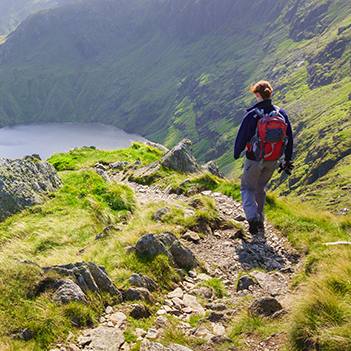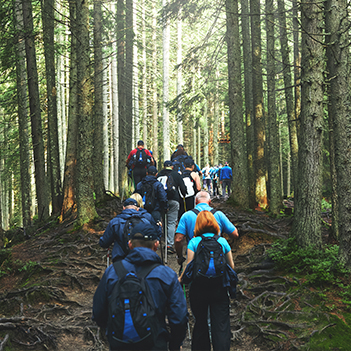Route Sections
Information and pictures are regularly being added to this page.
Photos by John Henderson unless otherwise stated
|
HQ at Boat of Garten Our walk headquarters is at Boat of Garten, a village some 5 miles northeast of Aviemore with about 700 inhabitants. It can be reached from Aviemore by the regular 37/x37 bus service or by the less regular Strathspey Railway steam train. It is known for the nearby Loch Garten Osprey Centre; there is an attractive church, St Columba’s, as well as a Co-op and post office. The village lies on the River Spey, and its name is taken from the former ferry. The Spey is 98 miles long and will feature prominently in our journey. Its source is at Loch Spey, a remote loch between Glen Roy and the Corrieyairack Pass. Before Boat of Garten it flows through Newtonmore, Kingussie, Aviemore and then on through Granton on Spey, Aberlour and Fochabers to reach the Moray Firth at Spey Bay, 5 miles west of Buckie. Much of our route is along the Speyside Way, an 85 mile route from Newtonmore to Buckie on the Moray coast; it is well-maintained as one of the four 'official' long distance routes in Scotland. We also make use of its 15 mile spur down to Tomintoul. Look out for the 'hexagonal thistle' waymarks. |
|
Section 1: Boat of Garten to Nethy Bridge On leaving the Community Hall, our walk passes under the steam railway and crosses the Spey. Easy walking along the Speyside Way takes us through the Abernethy Forest, a remnant of a caledonian pine forest. We cross the River Nethy, a tributary of the Spey, by the narrow stone bridge built in 1810 to a design by Thomas Telford to reach the first checkpoint, outside the Community Hall at Nethy Bridge. The village was industrially important with forestry, wood processing and ore extraction, but now tourism is the main activity. Altmore House, a large mansion built around 1914 on the Altmore Estate just north of the village, was bought by Bob Dylan in 2006 as his Scottish residence, but was sold to Angus Dundee Distillers in November 2023.
|
|
Section 2: Nethy Bridge to Grantown-on-Spey This is another flat and straightforward section along the Speyside Way. We leave Nethy Bridge passing the old station and follow the disused railway for five miles, with the ruins of Castle Roy visible on the right. This used to be the Strathspey Railway line from Boat of Garten to Dufftown (but we have to walk there!), a line that opened in the 1860s but closed to passengers in 1965. After crossing the busy A95 we pass the former Grantown-on-Spey East station, to cross the Old Spey Bridge and through Anagach Wood, a native pinewood, to the Grantown-on-Spey outward checkpoint at the Inverallan Church Hall. With a population of 2,500 Grantown is the largest town on the route. It was established in 1765, planned by the head of the Grant clan, Sir James Grant, after whom it is named. The town flourished economically in the late 18th and early 19th century with several factories, linen manufacture and as a market town. The spacious ‘Square’ is a central feature with a prominent war memorial, a recently restored Mercat Cross, a former orphanage with a clock tower, and several hotels, including the impressive Grant Arms Hotel where Queen Victoria once stayed. In the main street there are plentiful cafes and coffee shops, a good size Co-op and a range of other shops. |
|
Section 3: Grantown-on-Spey to Cromdale Leaving Grantown, the route joins the Dava Way for a couple of miles. The Dava Way is a 24 mile LDP from Grantown on Spey that mainly follows the route of the former Highland Railway, which opened in 1863 between Perth and Inverness and closed in 1965. Our route takes us through a steep-sided-cutting and then onto an embankment to cross the main A939 at 'Lady Catherine's Halt' by the turreted West Lodge of Castle Grant. Our route swings southeastwards, with fine views across to the Cromdale hills, to pass Castle Grant itself. The substantial Castle was the former seat of the Clan Grant chiefs. The original tower dates from the 14th century with parts added later, in particular a massive extension by John Adam in the 1750s. It fell into disrepair in the mid 20th century, but was restored in the 1990s and is now a private residence. Our route continues through Upper Tomvaich Wood to pass the four Upper Port standing stones in the distance on the right. We reach and cross Cromdale Bridge, a steel box-girder bridge over the Spey built in 1922 to replace an earlier bridge, adjacent to an attractive church and graveyard. Joining the Kirk Road to we cross the former railway near the old station to reach the small village of Cromdale, meaning ‘crooked dale’, and the village hall checkpoint. Remarkably this tiny village boasts two football teams: Spey Valley United and Cromdale F.C.. Two miles to the west, on the Haughs of Cromdale, the Battle of Cromdale in 1690 saw the Jacobites routed with heavy losses by government troops under Sir Thomas Livingston. Balmenach Distillery lies a mile to the south of the village.
|
|
Section 4: Cromdale to Ballcorach This is the first section of the route with upland terrain as we cross the Cromdale ridge which rises to over 2,300ft. From Cromdale, we follow a minor road for a couple of miles, before turning off right for the first big climb of the walk. We follow tracks to pass a series of grouse butts, as we ascend a spur to reach a gate onto the ridge of the Hills of Cromdale. We follow the rough heathery ridge to a cairn at 1,910ft, the highest point on the route. From here several hundred yards of rough ground leads to the top of a wide stony track (there will be white marker posts here). We descend steeply on the track to Knock Farm from where a farm track leads to Ballcorach outdoor checkpoint in Strath Avon. Marilyn baggers may wish to return to the Cromdale ridge on another occasion: our walk passes through the col between Creagan a’ Chaise (2,369ft, 722m) and Carn a Ghille Chearr (2,330ft, 710m). |
|
Section 5: Ballcorach to Tomintoul A riverside track leads usto a Bailey style bridge over the River Avon. We then ascend through Ballenlish Farm, above the riverside Tomintoul distillery, and through a large open area where there may be usually placid Belted Galloway cattle. We follow an undulating track popular with mountain bikers through forestry and then opening out. Our track follows the meandering Chabet Water to Glenconglass to join a minor road and eventually the Speyside Way spur to reach the main road through Tomintoul and the checkpoint at the Richmond Hall. Tomintoul, from the Gaelic ‘Tom an t-Sabhail’ meaning Hillock of the Barn, lies on the River Avon, and at 1,130 feet (345m) above sea level has claims to be the highest village in the Highlands. The long narrow village with its neat town square was constructed on a grid pattern by the 4th Duke of Gordon in 1775 and was sited on one of William Caulfield’s military roads. The duke hoped that such a village would reduce the cattle theft and illegal distilling prevalent in the area in the 1700s. Nevertheless, in 1820 some 14,000 illegal stills were confiscated in the area. The 1824 Excise Act permitted making whisky under licence and enabled some to make a legal profit. Tourism is now a major industry, with a range of accommodation including a hostel, and the annual Glenlivet Walking Festival. The Tomintoul and Glenlivet Discovery Centre is worth a visit. |
|
Section 6: Tomintoul to Glenlivet This section follows a very attractive length of the Speyside Way spur. The route leaves Tomintoul by a different route to rejoin the Speyside Way which we follow for the rest of this section. On leaving the road we reach a wide sheep-grazed open moorland section. After passing through a forest we climb up through an open area to gain the summit of Carn Daimh (1,870ft, 569m), a Marilyn with a topograph, large cairn and great views. From there, we gradually descend through open ground with great, passing notices reminding us that we are in an International Dark Sky Area, with other notices indicating the source of the water used for Glenlivet whisky. We join a minor road with the remains of Blairfindy Castle on the right and then go between buildings of the famous Glenlivet Distillery - savour the changing aromas as you pass and glance at the huge copper stills! A track and path take us across the River Livet to the hall at Tombreckachie. |
|
Section 7: Glenlivet to Recletich This section follows quiet lanes with some forest track. We leave the checkpoint eastwards on a lane alongside the Burn of Tervie, which we soon cross, and continue, passing a few farms, to reach the B9009 at Craighead. Over the road our track through the Mornish Forest skirts the site of the Battle of Glenlivet in 1594, at which Catholic forces of the local Clans Gordon and Campbell defeated the much larger Protestant forces led by the 7th Earl of Argyll, loyal to James VI (of Scotland), who were unfamiliar with fighting in that type of terrain. We reach a lane end at a remote cottage at Badeach and follow the lane through Glen Rinnes for 4½ miles, with fine views across the Glen to the Corbett Ben Rinnes (2,756ft, 840m) and the new Glenrinnes Distillery, with Corryhabbie Hill (2,561ft, 781m), another Corbett, to the southeast. We pass the small church and cemetery at Kirkhill to reach the barn checkpoint at Recletich Farm. |
|
Section 8: Recletich to Dufftown After a short distance along the B9009 we turn left to go up a lane through the steep sided Glen Harnes to enter the forest and follow the track through the Glach-en-ronack pass, which goes through the bealach (Scottish for col) between Meikle Conval (1,873ft, 571m) to the north and Little Conval (1,811ft, 552m), both Marilyns. The path follows pylons back down to the B9009 which we cross to a minor road leading into Dufftown, and pass the Mortlach Distillery to reach the breakfast checkpoint at the Mortlach Memorial Hall. Dufftown is in the ancient parish of Mortlach where St Moulag established a Christian church around 566AD. The town was founded as a Burgh in 1817 by James Duff, Earl of Fife, after whom it is named. The grid style of streets is reminiscent of those in Grantown-in-Spey and Tomintoul, with the four main streets meeting at the square Clock Tower, previously used as a prison but now a tourist information centre. The town lies on the River Fiddich and now has a population of about 1,600. The Keith and Dufftown heritage railway runs north-eastwards from here to Keith. The town is hailed as the "Whisky Capital of the World", with the Balvernie, Pittyvaich, Dufftown, Glendullan, Glenfiddich, Kininvie, Mortlach and Pittyvaich distilleries all in the town or on its outskirts. |
|
Section 9: Dufftown to Aberlour We walk northwards out of Dufftown past the impressive Balvenie Castle, built in the 12th century by the Comyn earls of Buchan who ruled this part of Scotland. Robert the Bruce overthrew these lords and took the castle in 1308. At various times it was occupied by the Black Douglases and then the Earls of Atholl. The castle was abandoned in the early 18th century and the ruins are now managed by Historic Environment Scotland. We pass the Glenfiddich Distillery and then Dufftown Station, the western terminus of the Keith and Dufftown Railway. Opposite the Balvenie distillery we join the Speyside Way, which we follow for most of the rest of the walk, largely along the railway track's continuation along the disused Strathspey Railway, which until 1965 took passengers to Grantown-on-Spey. We keep close to the River Fiddich which meanders westwards and which we cross twice before it joins the Spey, to reach the village of Craigellachie (meaning ‘rocky hill’). The village dates back to the mid-18th century and hosts the Craigellachie and The Macallan distilleries. The impressive cast iron arch Craigellachie Bridge over the Spey was built by Telford in 1814. We continue along the old railway track, now next to the Spey, and enjoy the smell of shortbread as we pass the famous Walkers shortbread factory to reach the Fleming Hall at Aberlour. |
|
Section 10: Aberlour to Tamdhu This section follows the Speyside Way along the former Strathspey Railway line keeping close to the River Spey. We pass Daluaine Distillery and cross the Bridge of Carron, a cast iron bridge built in 1893 to a design by Alexander Gibb, with the modern glass-fronted Dulmunach Distillery on the left. The path meanders beside the Spey to pass the neighbouring Knockando and Tamdhu distilleries with the checkpoint adjacent to the latter. |
|
Section 11: Tamdhu to Advie We continue along the old Strathspey railway route, remaining close to the river. Just after its confluence with the River Avon, we cross the Spey by the impressive wrought-iron lattice girder Ballindalloch bridge, also designed by Alexander Gibb. The fine Ballindalloch Castle, home of the Macpherson-Grants since 1546, with its extensive grounds is over to the left beside the Avon. A mile beyond Cragganmore and its distillery, the Speyside way turns left to follow an inland route for a while, but we continue along the railway to reach the checkpoint at Advie village hall. |
|
Section 12: Advie to Cromdale Leaving Ardvie we cross the main A95 and ascend through the Woods of Knockfrink to rejoin the Speyside Way which was rerouted around farm land. We follow a rocky up and down route round the hillside above the main road and the river, going through many chain-stiles. We then join a forest track to reach and cross the main road to regain the old railway into Cromdale where we revisit the Village Hall. |
|
Section 13: Cromdale to Grantown-on-Spey We leave Cromdale along the Kirk road, crossing the old railway by Cromdale Station, to reach the church and graveyard and the box-girder bridge over the Spey. From here back to Grantown-on-Spey the route stays on the Speyside Way on a good track through Anagach Woods with many finger-posts and waymarks. Passing the Grantown curling rink, we enter the town and soon reach the checkpoint at the British Legion Hall - a different venue in Grantown from that visited on the outward journey. |
|
Section 14: Grantown-on-Spey to Nethy Bridge We continue to reverse our outward route along the old railway to Nethy Bridge, this time the checkpoint is inside the Community Hall. |
|
Section 15: Nethy Bridge to Boat of Garten We cross the bridge over the Nethy and return through Abernethy Forest, but now after crossing the River Spey for the last time we stay on the main street of Boat of Garten to turn left to walk HQ and the finish. |














































































